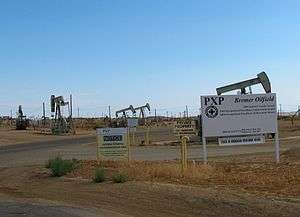Plains Exploration & Production
|
| |
| Public company | |
| Traded as | NYSE: PXP |
| Industry | Oil and gas |
| Founded | 2002 |
| Headquarters | Houston, TX, USA |
Area served | North America |
Key people |
James C. Flores (Chairman), (President) & (CEO) |
| Products |
Petrochemical Natural gas |
| Revenue |
|
|
| |
|
| |
| Total assets |
|
| Total equity |
|
Number of employees | 806 (2009) |
| Website |
www |

Plains Exploration & Production was an American petroleum company based in Houston, Texas. A spin-off from Plains Resources, Inc., the company was founded in 2002. Its operations, as of 2009, were all in North America, including California, Texas, Louisiana, Wyoming, and offshore of California and in the Gulf of Mexico. The company reported proved reserves of 292 million barrels of oil equivalent (BOE) at the end of 2008, with a potential total of over 2.2 billion BOE. In 2007, it was the fourth-largest oil producer in California (behind Chevron Corp., Aera Energy, and Occidental Petroleum).[1] It was acquired by Freeport-McMoRan in May 2013, at which time the former properties of PXP became part of the FCX Oil & Gas Inc. (FM O&G) division of Freeport-McMoRan.[2][3]
History
Plains Exploration & Production (PXP) was a spinoff from Plains Resources Inc., to which it was a subsidiary prior to 2002. Plains Resources at that time was a midstream production and transport company, but it spun off its exploration component on December 18, 2002 in order to focus on marketing, storage, transport, and terminalling of crude oil.[4] PXP grew further through the 2003 acquisition of 3TEC for approximately $313 million, and acquired Nuevo Energy in May 2004 for $945 million. These acquisitions gave it petroleum-producing assets scattered throughout the southwest and California.[4]
Subsidiaries
As of the beginning of 2008, Plains had numerous subsidiaries, including Arroyo Grande Land Company LLC (as Plains runs the Arroyo Grande Oil Field in San Luis Obispo County, California); Nuevo Energy, Nuevo Resources, and Nuevo International; Latigo Petroleum; Montebello Land Company; and Pogo Producing Company, which has branches outside the U.S. (Alberta, New Zealand, Vietnam).[5]
Operations
As indicated by its name, Plains was primarily an oil and gas exploration and production company, and had many active petroleum fields in the United States, offshore in the Gulf of Mexico, as well as a prospect offshore of Vietnam. The company's stated strategy was to develop mature fields with a long reserve life, occasionally adding new prospects to maintain a consistent cash flow.
As of 2009, its core holdings were gas fields in Wyoming and Colorado; oil and gas fields in Texas, Louisiana, and the Gulf of Mexico; and oil fields in California, both onshore and offshore.[6] In California it was a principal operator on numerous fields, from Cymric and the South Belridge in Kern County to Inglewood in Los Angeles County. Many of its active operations were in the Los Angeles basin directly underneath Los Angeles and adjacent cities. Plains reported 2,602 active oil wells in 2008 in California alone.[7]
A joint venture in 2008 with partner Chesapeake Energy gave Plains a strong position in the development of the Haynesville shale gas play in northwestern Louisiana as well as extreme eastern Texas and southwestern Arkansas. At the end of 2008, Plains had 113,000 acres (460 km2) and 50 drilling rigs in conjunction with Chesapeake.[8] As of late 2010, Plains had closed on the purchase of approximately 60,000 net acres in the Eagle Ford oil and gas condensate windows in South Texas.
Plains attempted to negotiate a complex compromise deal in Santa Barbara County with environmental groups and state regulators in which the firm would be able to drill into the undeveloped Tranquillon Ridge, off the western coast of the county, in return for decommissioning and doing environmental restoration on the old and mostly played-out Lompoc Oil Field, which consists of approximately 3,700 acres (15 km2) of ecologically-sensitive habitat adjacent to the Burton Mesa Ecological Preserve. As part of the deal, Plains would have drilled into Tranquillon Ridge only from their existing Platform Irene, and would have retired the platform entirely in 2022. The project would have given the state of California $2 billion in tax revenues during that time, and Santa Barbara County about $350 million. The County Board of Supervisors voted to approve the project and sent it on to the State Lands Commission, which rejected it by a 2 to 1 vote on January 29, 2009, citing the unenforcability of the sunset clause.[9]

In May 2009, however, California Governor Arnold Schwarzenegger revived the project by including it in a revised budget proposal.[10] While this proposal did not pass, Plains announced that it would continue to try to persuade voters and legislators of the merits of the exchange.[11]
Notes
- ↑ California Department of Conservation, 2008 Annual Report
- ↑ Freeport-McMoRan Copper & Gold Inc. Completes Acquisition of Plains Exploration & Production Company
- ↑ Quarterly Report, 3rd Quarter 2014, Freeport-McMoran
- 1 2 SEC Filing: Form 10-K/A, December 31, 2003
- ↑ Plains Exploration & Production Form 10-K SEC filing for 2007; full list of subsidiaries
- ↑ Plains Exploration & Production Co., Form 10-K, for period ending December 31, 2008
- ↑ "2008 Report of the state oil & gas supervisor" (PDF). Department of Oil, Gas, and Geothermal Resources. California Department of Conservation. 2009. Retrieved January 3, 2010. pp. 145–146
- ↑ Haynesville Shale article at Investopedia
- ↑ Stewart, Ethan (January 29, 2009). "PXP Deal Defeated". Santa Barbara Independent. Retrieved January 5, 2010.
- ↑ Roberts, Jerry (May 14, 2009). "Tranquillon Ridge Project Returns". Santa Barbara Independent. Retrieved January 5, 2010.
- ↑ "PXP's Tranquillon Ridge Project Update". PRNewswire-FirstCall; iStockAnalyst. July 26, 2009. Retrieved January 5, 2010.